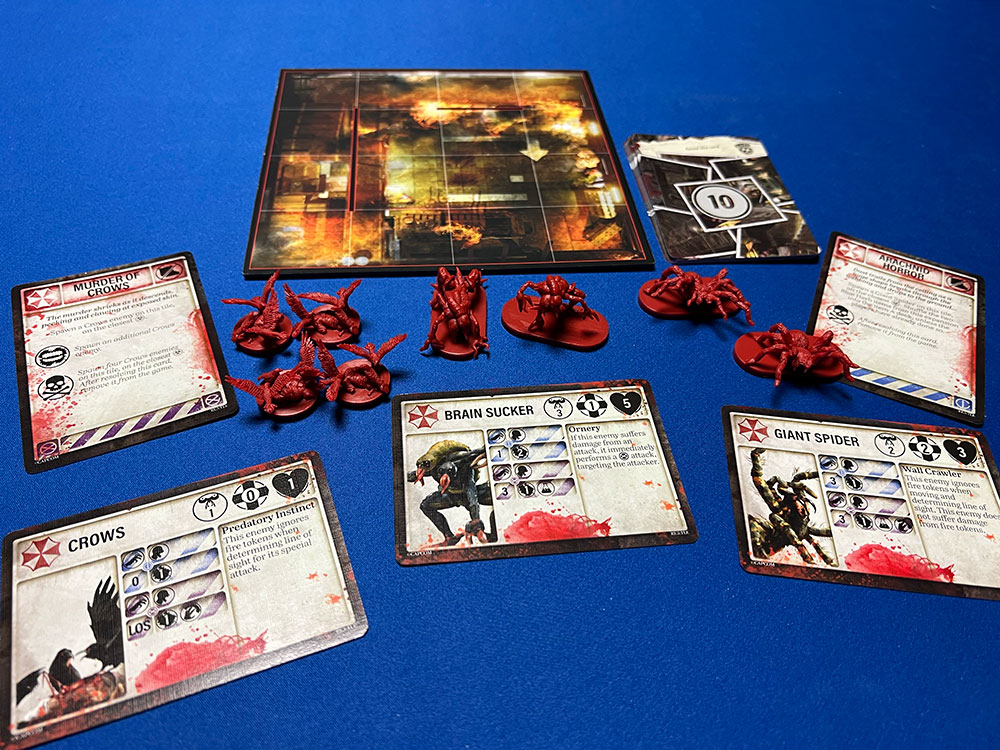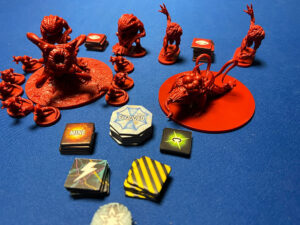 I really liked Resident Evil 3. I was lucky enough to receive the City of Ruin expansion to review as well. But I wanted more. As I wrote in my review of the core game, one of the misses was the lack of characters and enemies in the retail version. I remedied that by going to the Steam Forged Games website and purchasing The Last Escape expansion, which includes most of the stretch goals from the Resident Evil 3 Kickstarter campaign. Here are my thoughts on these two expansions.
I really liked Resident Evil 3. I was lucky enough to receive the City of Ruin expansion to review as well. But I wanted more. As I wrote in my review of the core game, one of the misses was the lack of characters and enemies in the retail version. I remedied that by going to the Steam Forged Games website and purchasing The Last Escape expansion, which includes most of the stretch goals from the Resident Evil 3 Kickstarter campaign. Here are my thoughts on these two expansions.
Expansion Overviews:
The Last Escape adds the following: 6 new characters and their profile cards, 7 minis (one of the characters has 2 sculpts), 6 cards for the advanced versions of a character (4 for the base game and 2 for this expansion), 9 item/starter cards and 1 survivor card, 3 new enemy types (8 minis total) and their reference cards, 2 tension cards, 10 narrative cards, 10 epilogue cards, 17 mad jackal cards (new game mode), and 1 tile.
City of Ruin adds the following: New 9 scenario campaigns, 2 bosses (2 minis), their references cards and behavior cards, 3 new enemy types (two types of Hunters and sliding worms, 12 minis total) and their reference cards, 33 item cards, 7 door cards, 8 tension cards, 6 tiles, and a bunch of tokens.

Game Experience with the Expansions:
The Last Escape
The Last Escape expansion improves the original campaign in several ways. Most importantly, the expansion adds six new characters (bringing the total to 10) with some interesting options. For example, Darrio Rosso, a civilian, is not good at fighting, but has an inventory capacity of eight and can discard an ink ribbon to reduce the city threat level by one. Then there is Murphy Seeker, who can reroll any attack by using an action, but if he is ever knocked unconscious, he is eliminated and replaced with a zombie! These new characters are brought into the game through the narrative cards included in the expansion; however, there is a variant to choose them at the start (spoiler: I used that variant. I wanted to try the new options right away).

Finally, you can include advanced cards. If you complete an unlocking requirement listed in the rulebook, you can swap out the regular version of the card with an advanced version for your character. Unfortunately, not all of these cards are improvements. For example, Jill loses her beloved Reposition skill and Last Escape to be able to reshuffle a non-narrative card back in the tension deck once per scenario and the ability to reroll attack dice against Nemesis. I believe some of these cards should have been more advanced. You could house rule that you could keep BOTH cards, but that might be overpowered.
Second, the expansion includes new enemies and gameplay rules. Crows, Giant Spiders, and Brain Suckers have now entered the game. They are added either through new Tension Deck cards and/or by replacing enemies from the base game. There are two significant additions to gameplay—the new epilogue cards and new narrative event cards. Epilogue cards give players a way to score how they performed in the campaign. I REALLY liked this addition as it provides something to chase after completing your campaign: to get a better score. The new narrative cards provide ways to introduce (and save) the new characters in the middle of your campaign. They also add some special encounters that remove your character from the board to a special encounter tile. I also liked these additions because of the variability they add to the campaign.
Finally, there are the new game modes, which I have sorted in order from my favorite to my least favorite:
• Operation: Mad Jackal – It is a solo game (one character) where the player tries to make their way past many enemies to diffuse a bomb. A new deck of cards is used to build the map as you go. I really enjoyed this mode as it let me play the tabletop version of one of mini games that were unlocked if you completed the RE3 videogame.
• Arrange Mode – this mode randomizes how the campaign progresses. This is great for breathing fresh air after you have completed the campaign several times.
• Survival Horror Mode – provides alternate ways to meet characters during the campaign outside of the narrative cards.
• Knife Only Mode – straight from the video game, you can TRY this crazy mode if you are looking for excitement and/or a quick death.
• Hard Mode and Nightmare Mode – I did not try these, but they ramp up the difficulty of the campaign.
I only have two gripes with this expansion, the unbalanced advanced cards (already discussed), and some of the additions are not elegantly added to the game. You will have to have the rulebook with you to integrate some of the new content. For example, the addition of the new characters in Survival Horror mode has to be read from the rule book. I would have preferred cards that I could pull out to reference rather than the rulebook.

City of Ruin
The City of Ruin expansion adds a new nine-scenario campaign that takes place IMMEDIATELY after completing the campaign. In fact, you keep the equipment that is in your possession at the end of the game. I do not want to spoil the campaign, but I will give a general overview of it.
First of all, the campaign is linear. It took me a bit to get used to this as I LOVED the more open format of the original. The benefit of this format is that the designers can provide a more fluid narrative as your characters try to escape the city. By the time I finished the campaign, I appreciated the narrative it provided but did miss the more open format I was sued to.

The expansion adds Sliding Worms, Hunters (two types) as well as two new bosses with massive (two by two square sized) bases. I loved the new mechanism tied to Hunters (doing certain actions makes it more likely they will hunt you). And the new boss battles provide unique challenges that you have not faced before. These additions were all great!
Finally, the campaign adds new weapons, ammo, and terrain elements. While I liked the new weapons, I REALLY liked the new ammo types. They are more powerful than basic ammunition, but if you reload before they are all used they are lost, so timing reloads is critical. I also liked the use of power tokens to unlock areas of the map, as well as navigating flooded areas and the slower movement it causes (especially when being hunted as water does NOT slow down enemies).
I really enjoyed the additional campaign. If you loved the base game, and do not mind a linear experience, this expansion may be perfect for you.
Final Thoughts:
I liked both expansions. I would highly recommend getting both if you enjoy Resident Evil 3. They are completely different in scope. The Last Escape enhances the base campaign while City of Ruin provides a new campaign.
If you only want one expansion, I honestly could not choose one over the other. If you want to expand your options for the original game, then I would recommend The Last Escape. If you are looking for a new campaign, then City of Ruin would be the better option. Either way, you cannot go wrong.
 The Last Escape
The Last Escape
Hits:
• New characters and enemies
• Epilogue cards
• New game modes
Misses:
• Integration of some new elements is not elegant
• Some of the advanced cards are worse than their standard cards
 City of Ruin
City of Ruin
Hits:
• 9 more Resident Evil 3 scenarios
• Hunter mechanism
• New weapons, ammo and terrain impacts
Misses:
• Campaign is linear





















